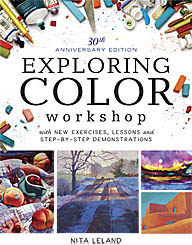Art and Alzheimer's
Read The Pablo Picasso Alzheimer's Therapy in the New York Times. The implications of this article are thrilling. Several different programs suggest that Alzheimer's patients become more responsive and vital after visiting museums and looking at art. Some talk about it; others are entertained by it. These are people who show little interest or response to most other stimuli, although they are not yet lost to the devastating destruction of the mind that Alzheimer's causes.
My mother had severe senile dementia. For several years she lived in a controlled facility for the memory-disabled, including many with mid-stage Alzheimer's. Several times while she lived there I made collages with a small group of residents. The first time, I was told they wouldn't last twenty minutes, but they were with me for an hour and a half. I had selected pages from magazines I thought they might like. They loved the antique dolls, country kitchens, baby animals and food, oohing and aahing as they picked out images for their pictures. They had no problems with tearing out the images and arranging them on the page, but when some tried to use the glue stick, they couldn't remember what it was for. Once I started their hands in motion, they could do it. Every one of the eight completed a picture and was thrilled with it. A few couldn't remember their names to sign on the picture. On Valentine's Day we decorated big red hearts with doilies, which they all remembered doing as children. On another occasion we played with rubber stamps. Each time they became immersed in the task, talking about the images in their pictures and the colors, occasionally bringing up an old memory stirred up by an image. A visitor looking in wouldn't have suspected that these "artists" had memory problems.
If you'd like to do this when you visit an elderly relative or friend, here are some suggestions. First, speak to the activities director and set a time so they can have space set up for you. You might feel more comfortable for the first time working with fully functional elderly folks. Start with four people if you're by yourself, or eight if you have someone to help you. All you need is a stack of colorful pictures for them to tear up, non-toxic glue sticks and colored construction paper or white copy paper. Other embellishments, such as ribbon, yarn and stickers are fun, too.
My mother had severe senile dementia. For several years she lived in a controlled facility for the memory-disabled, including many with mid-stage Alzheimer's. Several times while she lived there I made collages with a small group of residents. The first time, I was told they wouldn't last twenty minutes, but they were with me for an hour and a half. I had selected pages from magazines I thought they might like. They loved the antique dolls, country kitchens, baby animals and food, oohing and aahing as they picked out images for their pictures. They had no problems with tearing out the images and arranging them on the page, but when some tried to use the glue stick, they couldn't remember what it was for. Once I started their hands in motion, they could do it. Every one of the eight completed a picture and was thrilled with it. A few couldn't remember their names to sign on the picture. On Valentine's Day we decorated big red hearts with doilies, which they all remembered doing as children. On another occasion we played with rubber stamps. Each time they became immersed in the task, talking about the images in their pictures and the colors, occasionally bringing up an old memory stirred up by an image. A visitor looking in wouldn't have suspected that these "artists" had memory problems.
If you'd like to do this when you visit an elderly relative or friend, here are some suggestions. First, speak to the activities director and set a time so they can have space set up for you. You might feel more comfortable for the first time working with fully functional elderly folks. Start with four people if you're by yourself, or eight if you have someone to help you. All you need is a stack of colorful pictures for them to tear up, non-toxic glue sticks and colored construction paper or white copy paper. Other embellishments, such as ribbon, yarn and stickers are fun, too.
Labels: art therapy, collage, new york times, picasso





0 Comments:
Post a Comment
<< Home